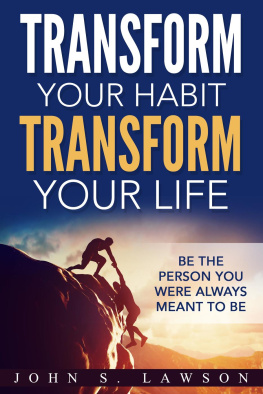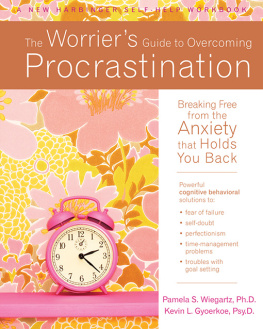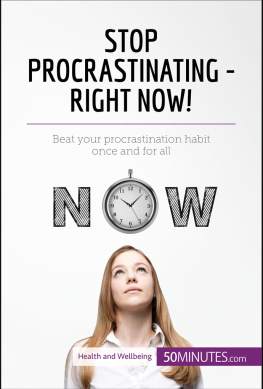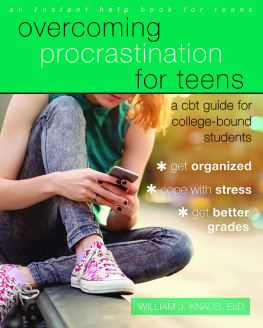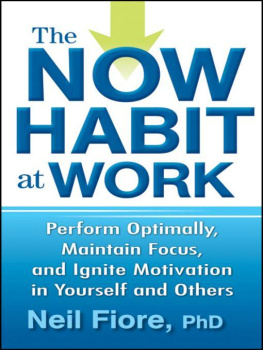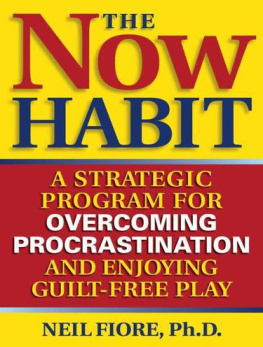Table of Contents
ALSO BY NEIL A. FIORE
The Road Back to Health:
Coping with the Emotional Aspects of Cancer
Awaken Your Strongest Self: Break Free of Stress, Inner Conflict, and Self-Sabotage
With Susan C. Pescar
Conquering Test Anxiety
JEREMY P. TARCHER/PENGUIN
a member of Penguin Group (USA) Inc. New York
This book is dedicated to all those people who had the courage and perseverance to seek help with the frustrating problem of procrastination. It has been written for all those who, in their quest for help, brought with them a battered sense of self-worth, a desire to save some part of themselves, and a burning conviction that they had some good work to contribute. But most especially, this book is for Elizabeth.
ACKNOWLEDGMENTS
This book came out of my own struggles with procrastination, motivation, and creativity, but in large part it is based on the experiences of thousands of coaching and therapy clients and seminar participants who have shared their difficulties and their triumphs with me. I wish to acknowledge the contribution of these courageous individuals who repeatedly faced their fears and found within themselves the strength to try again. Their stories are told with the names, jobs, and situations changed to protect their privacy.
I also wish to acknowledge the constant support and love of my family and friends, who offered me so many guilt-free meals and opportunities for guilt-free play. The staff at the University of California Berkeleys Counseling Center deserves special mention for its support over many years. I want to thank Jeremy P. Tarcher, who believed in the early, rough draft of the manuscript and had the vision to see this book. I will continue to be grateful for the advice and help of my agents. I am very grateful to friends who read rough drafts and offered constructive criticism, but I especially appreciate the assistance of Jayne Walker and Harriet Whitman Lee. And I wish to acknowledge the editing skill and wise counsel of Hank Stine and the inspiration of Janice Gallagher, both of whom contributed greatly to the organization of this book.
FOREWORD TO THE NEW EDITION
Its been almost twenty years since The Now Habit was first published, and thirty years since I began to develop and test the strategies of putting guilt-free play into your schedule (creating an Unschedule) and choosing to start as ways to remove the obstacles to your natural motivation and optimal productivity.
Since then, in my seminars and private sessions with coaching and therapy clients, Ive been challenged by some of the most entrenched forms of procrastination. Repeatedly, Ive found that going back to Now Habit basicsthe Unschedule, fifteen to thirty minutes of uninterrupted work, and using the Flow State/Centering exerciseworks in most cases. The Now Habit has stood the test of time.
In this revised edition, Ive refined and clarified some concepts and exercises, but the essential message of
The Now Habit remains the same:
Procrastination is a habit you develop to cope with anxiety about starting or completing a task. It is your attempted solution to cope with tasks that are boring or overwhelming. When you use the Now Habit strategies to lower your anxiety, fears, and self-doubts, you can stop using procrastination as an escape and can double your productivity and, often, double your income. When you learn to work efficientlyin the Flow State or Zone, using more of your brain-cell poweryou have less reason to avoid important, top-priority tasks.
The Now Habit frees you of shame and blame and moves you to a leadership perspective in your life. From this awakened sense of a larger, stronger self, you are free of the inner conflict between the inner voices of you have to versus but I dont want to. You begin to live your life from choicea leadership function of your higher, human brain and your new identity as a producer.
The Now Habit exercises help you break the cycle of procrastination by removing the stigma of calling yourself a procrastinator whos burdened by having to get so many things done. Instead, you become like martial artists and peak-performing athletes who can push aside distracting thoughts and focus their attention on what they can do now. You dont have to wait until you feel confident, motivated, or until you know it all; you start now and see what comes to you. You rapidly shift from not knowing to knowingwhich is the essence of creativity.
Much has changed in the world since The Now Habit was first published in 1989. Surfing the Internet, instant messaging, e-mailing, and the use of cell phones have added to the number of distractions that can seduce us away from our mission of starting on a major project that could change our lives. Because these new devices give us an immediate response, they have an unfair competitive edge over activities that will not be rewarded until the end of the month oras in the case of finishing school, writing a book, or learning to play the pianountil after one to four years of intensive work. All the more reason to use the tools offered you by The Now Habit.
Another change is that readers of The Now Habit have contacted me for coaching on how to apply the books strategies to managing others and to their personal lives as well as their work. This has given me additional insights into what you, the reader, need in order to make the Now Habit a powerful tool in shifting you from a Procrastinator (or an overwhelmed workaholic) into an efficient Producer who wants greater work-life balance.
We all need to use strategies and techniques to avoid the pain that many of my clients have expressed to me: the pain of finding yourself, once again, at the end of another day and another week thinking, I didnt do any work on what matters most. I worked and kept busy, but I dont know what I did. This is the feeling that more and more of us are having as we become workaholics (the flip side of procrastination) who treat all tasks as urgent while avoiding the few, priority projects that contribute to the bottom-line and the satisfaction of doing something meaningful.
The changes in todays work settinglayoffs, cutbacks, and downsizingmean that more of us are doing work that was once done by two or three, and more of us are starting our own businesses. We, very understandably, feel overwhelmed and burnt out. All the more reason to learn to focus and work in the Flow State (Chapter 7), and try to maintain the work-life balance that underlies the strategies of this book.
Advances in research conducted by NIH (the National Institutes of Health) and in the fields of neuropsychology and behavioral medicine over the last twenty years have proven that we can take control over our negative habits if we follow a series of steps. Their findings support The Now Habits underlying principle of knowing when, where, and how to start a project, and how to replace procrastination with the healthy habits of producers. It seems that The Now Habit was ahead of its time.
Im more confident than ever that The Now Habits second edition can help a new generation of readers rid themselves of the procrastination habit and find that they are naturally motivated, productive people.
INTRODUCTION
Human nature has been sold short... [humans have] a higher nature which... includes the need for meaningful work, for responsibility, for creativeness, for being fair and just, for doing what is worthwhile and for preferring to do it well.
ABRAHAM H. MASLOW EUPSYCHIAN MANAGEMENT
Whether you are a professional, an entrepreneur, a middle manager, a writer, or a student who wants to overcome problems with procrastinationor if you simply want to be more efficient in completing complex and challenging projectsthis program will help you get results. If you are organized in your larger work projects, but find that the small, essential tasks of everyday living get ignored, the Now Habit will help you set priorities for, start, and complete these tasks as well. If you are a professional whose busy schedule doesnt allow for leisure time, the Now Habit strategic program will legitimize guilt-free play while it improves the quality and efficiency of your work.


